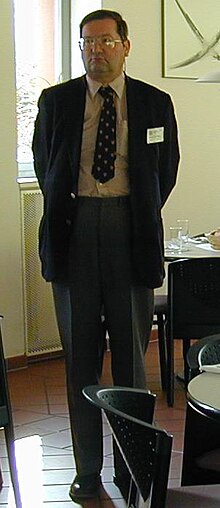| This article uses bare URLs, which are uninformative and vulnerable to link rot. Please consider converting them to full citations to ensure the article remains verifiable and maintains a consistent citation style. Several templates and tools are available to assist in formatting, such as reFill (documentation) and Citation bot (documentation). (September 2022) (Learn how and when to remove this message) |
| James DavenportTD CMath CITP FBCS FIMA | |
|---|---|
 Davenport in 2001 Davenport in 2001 | |
| Born | James Harold Davenport (1953-09-26) 26 September 1953 (age 71) |
| Education | Marlborough College |
| Alma mater | University of Cambridge (BA, PhD) |
| Awards | National Teaching Fellowship (2014) |
| Scientific career | |
| Fields | Cryptography Computer algebra systems |
| Institutions | University of Bath |
| Thesis | On the integration of algebraic functions (1979) |
| Doctoral advisor | John ffitch Arthur Norman |
| Website | people |
James Harold Davenport (born 26 September 1953) is a British computer scientist who works in computer algebra. Having done his PhD and early research at the Computer Laboratory, University of Cambridge, he is the Hebron and Medlock Professor of Information Technology at the University of Bath in Bath, England.
Education
Davenport was educated at Marlborough College, and was then a student at Trinity College, Cambridge. He was awarded a Bachelor of Arts degree in 1974, which was converted to a Master of Arts degree in 1978, and a Master of Mathematics in 2011. He was awarded a PhD in 1980.
Career and research
In 1969, the team that developed the automated teller machine in the United Kingdom at IBM Hursley used parts from that project to build an IBM School Computer. It was a community outreach project, and it went on tour. When it came to Marlborough College, Davenport, aged 16, discovered that, although it was ostensibly a six-digit computer, the microcode had access to a 12-digit internal register to do multiply/divide. He used this to implement Draim's algorithm from his father Harold Davenport's book, The Higher Arithmetic, and tested eight-digit numbers for primality.
Between school and university, Davenport worked in a government laboratory for nine months, again writing and using multiword arithmetic, but also using number theory to solve a problem in hashing, which was published. He was at IBM Yorktown Heights for a year, and returned to Cambridge as a Research Fellow. He went to Grenoble for a year, before taking a post at the University of Bath in 1983.
Davenport is an author of a textbook about computer algebra and of many papers. He has been Project Chair of the European OpenMath Project and its successor Thematic Network, with responsibilities for aligning OpenMath and MathML, producing Content Dictionaries and supervised a Reduce-based OpenMath/MathML translator, and was Treasurer of the European Mathematical Trust. He was Founding Editor-in-Chief of the London Mathematical Society's Journal of Computation and Mathematics.
Awards and honours
Davenport was awarded the Honorary Degree of Doctor of Science in September 2019 by the West University of Timişoara, Romania. This was in recognition of his pioneering and ongoing work in computer algebra systems and theory of symbolic computation.
In 2014, Davenport was awarded a National Teaching Fellowship by the Higher Education Academy.
He was awarded the Bronze Medal of the University of Helsinki in 2001.
From January to June 2017 Davenport was a Fulbright CyberSecurity Scholar at New York University, and maintained a blog over the same period.
In 2024, he was awarded Honorary Fellowship of BCS, The Chartered Institute for IT after many years service, including as a Vice-President.
Personal life
Davenport is the son of the mathematician Harold Davenport.
References
- ^ James H. Davenport publications indexed by Google Scholar

- ^ James H. Davenport at the Mathematics Genealogy Project

- James H. Davenport publications indexed by the Scopus bibliographic database. (subscription required)
- Marlborough College Register (11th ed.). 1997. p. 492.
- Davenport, James Harold (1979). On the integration of algebraic functions. cam.ac.uk (PhD thesis). University of Cambridge. OCLC 797099982. EThOS uk.bl.ethos.453038.
- ^ "Computing Reviews, Davenport, James". 1 October 2019. Archived from the original on 1 October 2019.
- Davenport, James Harold. On the integration of algebraic functions. Berlin; New York : Springer, 1981. 197 p.; 25 cm. ISBN 978-0-387-10290-0 (paperback)
- Computer algebra : systems and algorithms for algebraic computation / J.H. Davenport, Y. Siret, E. Tournier; translated from the French by A. Davenport and J.H. Davenport. London : San Diego : Academic Press, 1988. xix, 267 p. : ill.; 24 cm. ISBN 978-0-12-204230-0
- EUROCAL ’87 : European Conference on Computer Algebra, Leipzig, GDR, June 2–5, 1987 : proceedings / J.H. Davenport (ed.). Berlin; New York : Springer-Verlag, c1989. viii, 499 p. : ill.; 25 cm. ISBN 978-0-387-51517-5 (New York : acid-free paper) ISBN 978-3-540-51517-3 (Berlin : acid-free paper)
- Mathematical knowledge management : second international conference, MKM 2003, Bertinoro, Italy, February 16–18, 2003 : proceedings / Andrea Asperti, Bruno Buchberger, James H. Davenport (eds.).
- London Mathematical Society Journal of Computation and Mathematics: Editorial; Aims and Scope Archived 19 December 2008 at the Wayback Machine
- "James Davenport's Home Page".
- http://staff.bath.ac.uk/masjhd/blogplain.html
- "Roll of Honorary Fellows". BCS, The Chartered Institute for IT. Retrieved 29 September 2024.